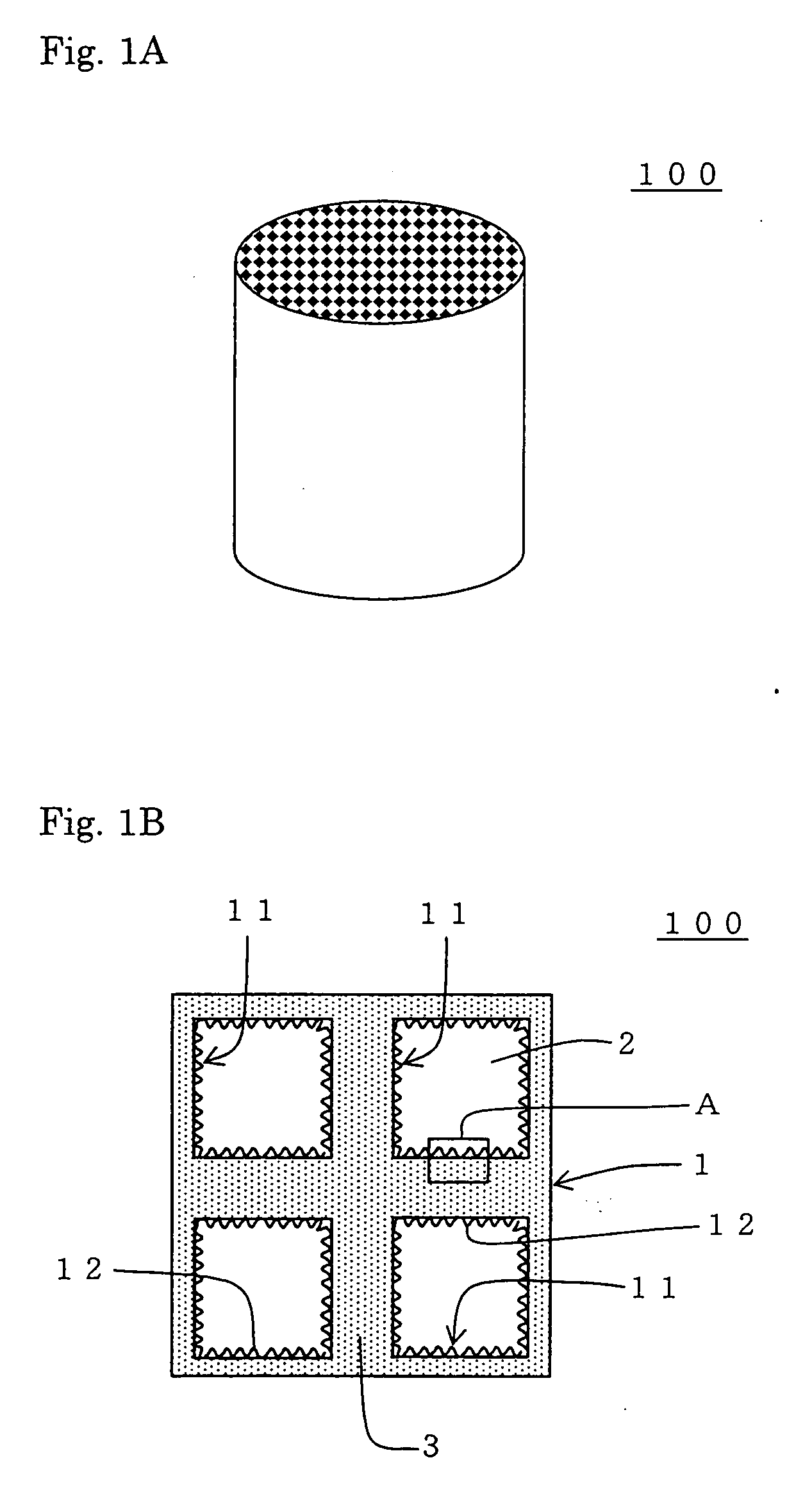Honeycomb structure
- Summary
- Abstract
- Description
- Claims
- Application Information
AI Technical Summary
Benefits of technology
Problems solved by technology
Method used
Image
Examples
example 1
[0094]To 100 parts by mass of a cordierite-forming raw material prepared by combining a plurality selected from talc, kaolin, calcined kaolin, alumina, calcium hydroxide, and silica at a predetermined ratio to obtain a chemical composition of 42 to 56% by mass of SiO2 (silica), 0 to 45% by mass of Al2O3 (alumina), and 12 to 16% by mass of MgO (magnesia) were added 12 to 25 parts by mass of graphite as a pore former and 5 to 15 parts by mass of synthetic resin. After suitable amounts of methyl celluloses and a surfactant are added to them, water was added, followed by mixing them to prepare kneaded clay. After vacuum deairing the kneaded clay, the kneaded clay was extrusion-formed to obtain a honeycomb formed article. Next, the honeycomb formed article was fired to obtain a honeycomb fired article (porous substrate). The firing conditions were 1400 to 1430° C. and 10 hours.
[0095]Next, plugging was performed to the honeycomb fired article. A mask was alternately applied on cell openin...
example 2
[0113]A porous substrate was manufactured in the same manner as in Example 1. A honeycomb structure having a catalyst loaded thereon was manufactured in the same manner as in Example 1 except that the particle size and the amount of the protrusion-forming material were adjusted. The coat layer obtained had a thickness of 15 μm, a porosity of 70%, and an average pore diameter of 15 μm. In the same manner as in Example 1, the average height of the protrusions (average protrusion height) average interval between the protrusions (average protrusion interval), surface area ratio, cell hydraulic diameter, pressure loss ratio, and regeneration time ratio were measured. The results are shown in Table 1.
example 3
[0114]The porous substrate was manufactured in the same manner as in Example 1. A honeycomb structure having a catalyst loaded thereon was manufactured in the same manner as in Example 1 except that the particle size and the amount of the protrusion-forming material were adjusted. The coat layer obtained had a thickness of 15 μm, a porosity of 70%, and an average pore diameter of 15 μm. In the same manner as in Example 1, the average height of the protrusions (average protrusion height) average interval between the protrusions (average protrusion interval), surface area ratio, cell hydraulic diameter, pressure loss ratio, and regeneration time ratio were measured. The results are shown in Table 1.
PUM
| Property | Measurement | Unit |
|---|---|---|
| Pore size | aaaaa | aaaaa |
| Pore size | aaaaa | aaaaa |
| Height | aaaaa | aaaaa |
Abstract
Description
Claims
Application Information
 Login to View More
Login to View More - R&D
- Intellectual Property
- Life Sciences
- Materials
- Tech Scout
- Unparalleled Data Quality
- Higher Quality Content
- 60% Fewer Hallucinations
Browse by: Latest US Patents, China's latest patents, Technical Efficacy Thesaurus, Application Domain, Technology Topic, Popular Technical Reports.
© 2025 PatSnap. All rights reserved.Legal|Privacy policy|Modern Slavery Act Transparency Statement|Sitemap|About US| Contact US: help@patsnap.com



